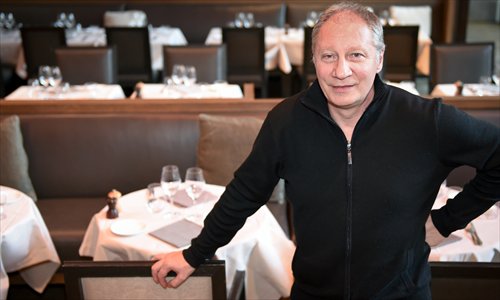HOME >> LIFE
Art for the belly
Source:AFP Published: 2015-3-19 22:33:01
Museums add gastronomic experiences to their collection

French chef Eric Frechon poses in the Grand Palais restaurant in Paris on February 11. Photo: AFP
Visitors to museums are long used to feasting their eyes on sumptuous works of art - but having to resort to little better than snack food for sustenance between galleries.Now, though, the temples of culture are increasingly turning attention to their eateries, looking to lift the fare on their tables to the same level as what's hanging on the walls.
The Guggenheim in Spain, New York's Museum of Modern Art and the Lucca Center of Contemporary Art in the Italian town of Lucca have taken the lead by starting luxury restaurants that have earned one star each in the Michelin Guide.
"The Guggenheim needed an avant-garde approach, an identity, a style - and that's what we did," Josean Alija, the chef at the Frank Gehry-designed museum in the Spanish town of Bilbao, told AFP.
Alija was just 19 when the Guggenheim opened in 1997 with him at the head of its Basque-flavored bistro.
In 2011, the museum decided to step things up a notch by opening Nerua, its high-end restaurant which won its Michelin star under Alija just a year later.
"It was an unprecedented gamble to join a museum to a first-class gastronomic restaurant," taken by museum director Juan Ignacio Vidarte, explained spokeswoman Begona Martinez.
'Competition between museums'
That movement towards better food and a real dining experience is taking hold elsewhere.
Paris' Louvre, Musee d'Orsay and Rodin Museum are listening harder to visitors' culinary expectations.
"There is competition between the museums, between countries, and the quality of their restaurants now is part of the criteria of fame or quality of a museum," Jean-François Camarty, the head of the big French company Elior Concessions that runs eateries for museums and companies, told AFP.
"As with all restaurants, there is a big jump in quality in terms of expectations and service," he said.
"But there also has to be outlets for all tastes and budgets," Camarty added. He pointed to the example of the Quai Branly Museum of ethnic art in Paris, which hosts both a less-costly cafe and a 50-euro-($55) a-head restaurant with a view of the Eiffel Tower.
Visitor experience
Ratcheting up the quality, and therefore prices, of some of their restaurants also adds to revenue.
"Of course there is a financial interest," admitted Marjories Lecointre, events and operations director at the Grand Palais in the French capital. "But it's not just that. We want people to feel good in themselves and to come back. It is part of the visitors' experience."
The Grand Palais, a vast and ornate, 19th-century glass-roofed events hall just off the Champs-Elysees, in 2009 opened its adjacent Minipalais restaurant, managed by the group Luderic.
The outlet offers a fixed-price menu of 29 euros, as well as other dishes conceived under an accomplished chef, Eric Frechon.
An annual international contemporary art show in the Grand Palais, FIAC, brings crowds to the restaurant, "but even when there are no events we have a Parisian customer base, coming from around the neighborhood," said Frechon.
For another three-Michelin-star chef, Gerald Passedat, who has a cooking school in the Museum of European and Mediterranean Civilizations in Marseille, it is important for a museum restaurant to echo its identity.
He carefully studied what the Guggenheim was doing before he started his school, which he wants to make "a catalyst for gastronomic Mediterranean cuisine." In that vein, this month he invited a two-star chef from Rome, Anthony Genovese, to participate in an event presenting refined Italian cooking.
Posted in: Food